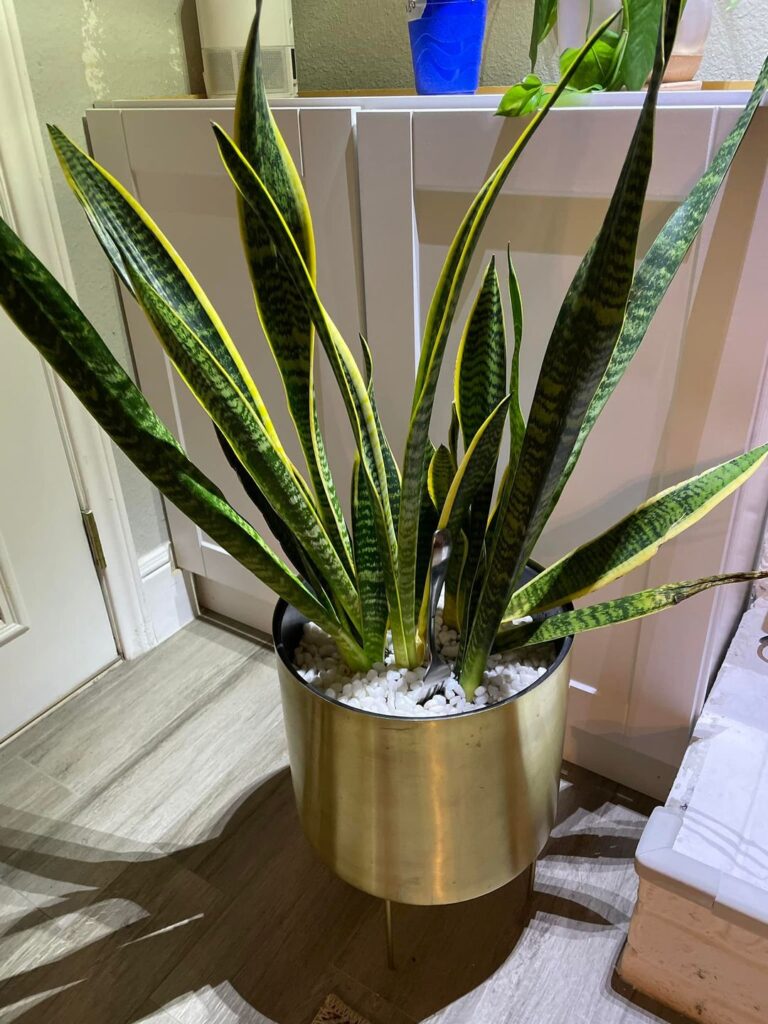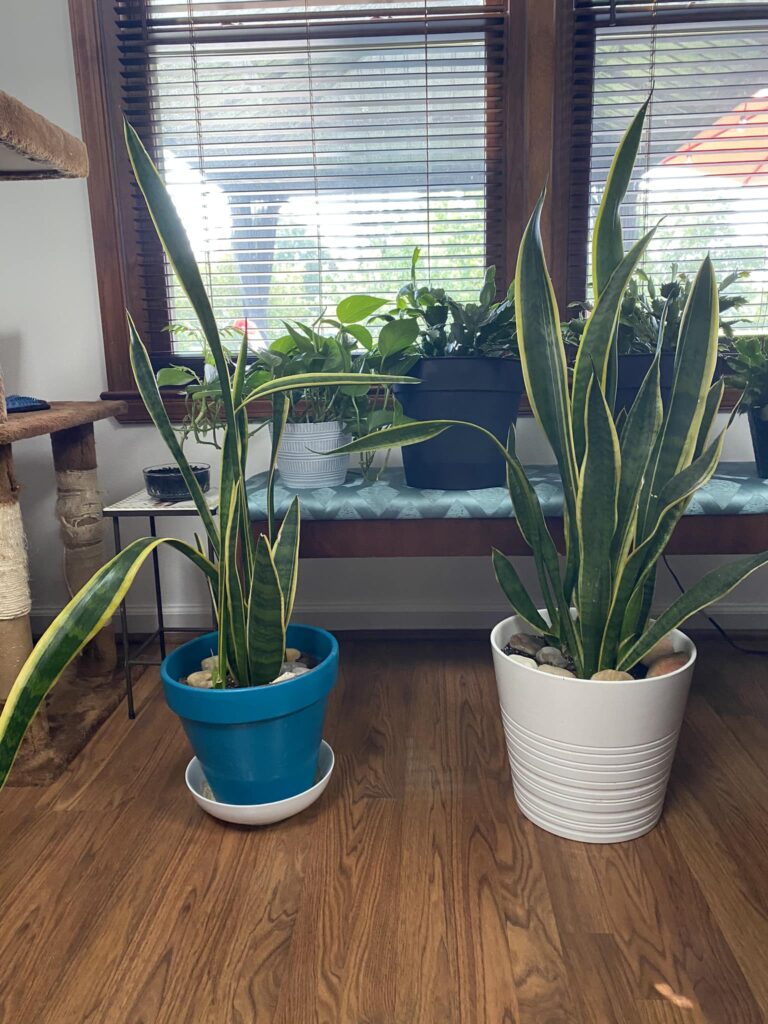With its striking appearance and low-maintenance requirements, the snake plant has earned its reputation as an excellent choice for beginners and seasoned plant lovers.
So whether you are looking for a succulent for your garden, indoor spaces, balcony, or anywhere else that could use some green, snake plant is worth considering.
Besides their striking appearance, snake plants are also highly resilient; in fact, killing them is nearly impossible.
However, do not neglect your snake plants because they still need love and care. Due to this, I decided to find out everything to know about caring for indoor snake plants.
Read this guide to learn how to care for indoor snake plants.
An Overview of Snake Plants
Before we delve into snake plant care, let’s do an overview of these intriguing plants. Snake plants, scientifically known as Sansevieria, are a popular group of indoor houseplants that many appreciate for their unique appearance, low maintenance requirements, and air-purifying qualities.
While native to West Africa, snake plants have gained popularity worldwide as it thrives indoors. It flourishes in arid regions and has evolved to withstand harsh conditions, making it a perfect candidate for indoor environments with less-than-ideal growing conditions.
This plant is popularly known as Mother-in-Law’s Tongue due to its sharp, upright, sword-like leaves that grow in a rosette-like pattern. The leaves of snake plants can be various hues of green, and some varieties have decorative yellow or white stripes.
One more thing: snake plants come in several cultivars and species, each featuring a unique leaf pattern and size. Common snake plant varieties include Sansevieria trifasciata (mother-in-law’s tongue), Sansevieria laurentii (variegated snake plant), and Sansevieria cylindrica (African spear or cylindrical snake plant).
You can grow snake plants all year round in USDA zones 8 or even warmer. This evergreen perennial also prefers slightly alkaline or slightly acidic soil. Beware that snake plants are toxic to dogs and cats.
Related Posts:
- How To Make Snake Plants Grow Taller And Straight
- Why Is My Snake Plant Drooping?
- Are Snake Plants Toxic To Dogs?
How to Care for Indoor Snake Plants
With the overview done, let’s focus on caring for these beautiful succulents.
1. Light Requirement For Snake Plant
For your snake plants to thrive, meet their light requirements. Snake plants prefer sun to part shade but can tolerate low-light conditions, making them suitable for areas in your home where other plants might struggle to thrive.
Below is a detailed breakdown of snake plant light requirements:
a) Low Light Tolerance
Since snake plants thrive in low light conditions, they can survive in rooms with just ambient or artificial light, such as offices, hallways, or corners that don’t receive direct sunlight.
However, remember that your snake plants will grow more slowly in low light, but worry not; they will remain healthy.
b) Moderate to Bright Indirect Light
Your snake plants will thrive and maintain their striking appearance in moderate to bright indirect light. Ideally, place your snake plant near a window facing east or north where it can bathe in filtered sunlight. These conditions promote more vigorous growth and better variegation of the leaves, making them the ideal light conditions for snake plants.
c) Direct Sunlight
Yes, snake plants can handle some direct sunlight, but they can suffer damage with the leaves getting scorched if you expose them to direct sunlight, especially in hot climates. Therefore, be cautious when exposing your indoor snake plants to intense sun. If you want to place your snake plant in direct sunlight, ensure it receives morning or late afternoon sun, which is less harsh than midday sun.
Also, be vigilant and monitor your plant for signs of sunburn, such as brown or bleached patches on the leaves.
2. Watering And Soil For Snake Plants
The health and longevity of your snake plants also depend on the right soil and watering conditions. So,
a) Let The Potting Soil Dry In Between Waterings
Before you water your snake plants, check the top inch or two (2.5-5 cm) of soil. Only water when it’s completely dry to the touch because these succulents are well-adapted to drought.
In most cases, this means watering approximately every 2-6 weeks during the growing season (spring and summer) and less frequently in the dormant season (fall and winter).
b) Use Well-Draining Soil
Plant your snake plant in a potting mix formulated for succulents and cacti. Alternatively, combine regular potting soil with perlite or coarse sand to create a DIY soil mix for your snake plants.
This soil type helps avoid overwatering and ensures proper drainage. With this soil, water won’t accumulate around the roots.
You can buy or make your own snake plant potting mix. Heavy, water-retentive soils can lead to moisture-related issues like root rot, so avoid them. Snake plants are adapted to dry, sandy soils in their native habitats.
c) Water Sparingly
When it’s time to water, do so sparingly. However, ensure you water thoroughly, making sure the water soaks through the drainage holes. This means watering until some water drains into the saucer the pot sits on.
Afterward, empty the saucer because letting your snake plants sit in standing water can cause root rot.
d) Use Room Temperature Water
Cold water can shock the roots of your snake plant, so use room-temperature water. Allow tap water to sit for a day, or use filtered water if your tap water contains a high amount of chlorine or minerals.
3. Temperature Range For Snake Plant
The average indoor temperatures suit snake plants, making these plants well-suited for most households. Snake plants thrive within a temperature range of 70°F to 90°F (21°C to 32°C) during the daytime. Also, they can tolerate slightly cooler temperatures at night, making them well-suited for typical indoor environments.
However, extreme cold isn’t good for snake plants, so protect them from exposure to cold drafts or temperatures under 50°F (10°C). Therefore, avoid placing them near open windows during winter or areas with direct exposure to cold air.
You will notice a reduction in your snake plant’s growth rate during winter due to reduced daylight hours and lower temperatures. However, this growth fluctuation is normal and not a cause for concern.
4. Humidity Requirements
Snake plants adapt to various humidity levels and can thrive in the average indoor humidity conditions found in most homes. However, they generally do well in the typical indoor humidity levels, typically ranging from 30% to 60%.
Consider occasionally misting the leaves of your snake plants with water if you live in an extremely dry environment or during the winter when indoor humidity levels drop significantly. This will help increase the humidity around the plant and prevent the tips of the leaves from becoming too dry.
Some moisture won’t harm your snake plants, but waterlogged conditions can impair their growth. Therefore, ensure the potting mix and pot provide good drainage.
5. Fertilizing Snake Plants
When you compare snake plants to other houseplants regarding fertilizing, snake plants are low maintenance. However, although they are not heavy feeders, proper fertilization helps ensure that your snake plant receives the necessary nutrients to maintain healthy growth and appearance.
Know when to fertilize your snake plants. Typically, the primary period for fertilizing is in spring and summer during their growing season. Aim to fertilize your snake plant every 4-6 weeks during this growing season.
Reduce or even omit fertilization during fall and winter, as your snake plants will enter a semi-dormant state, and their growth will slow down. When it comes to the types of fertilizers, you can choose a balanced, all-purpose liquid fertilizer with equal proportions of nitrogen (N), phosphorus (P), and potassium (K).
Alternatively, choose a specialized succulent or cactus fertilizer designed to meet the nutrient needs of plants like snake plants that prefer well-draining soil and have lower nutrient requirements. These specialized fertilizers often contain a higher proportion of potassium to promote root and foliage development.
6. Pruning Snake Plant
Since pruning is a crucial part of your snake plant care routine, strive to know why, when, and how to do it. Pruning helps remove dead or damaged leaves, control plant height, and encourage new growth.
While you can prune your snake plants at any time of the year, you will see better results if you do it during the active growing season, which typically spans spring through summer. Prune your snake plants with clean and sharp scissors, pruning shears, or gardening scissors.
Cut the unwanted leaves as close to the soil level as possible without damaging the surrounding healthy foliage. Also, prune the plant’s top portion just above a leaf node to control the height or trim back about one-third of the plant’s original height to rejuvenate an older plant.
7. Repotting Snake Plant
Your snake plants can go for years without needing repotting. However, if your plant becomes severely root-bound or outgrows its pot, it’s time to repot it into a slightly larger container. Repotting is typically needed every 2-5 years.
Summary
Caring for your snake plants is a hassle-free, rewarding experience. A bit of tender loving care goes a long way in ensuring your snake plants flourish indoors. This ensures you enjoy the beauty and benefits of snake plants in your home for several years.

Hey there, fellow plant enthusiasts! I’m Rachel, the green-thumbed writer behind Rooted In Garden. With a deep-rooted love for all things botanical, I’ve made it my mission to help you cultivate a thriving collection of houseplants. As a devoted plant parent myself, I understand the joys and challenges that come with nurturing these leafy wonders. Whether you’re a succulent aficionado, an orchid enthusiast, or simply adore all potted flora, join me on this journey as we explore the secrets to growing and caring for our beloved green companions. Together, let’s create a flourishing oasis indoors.


